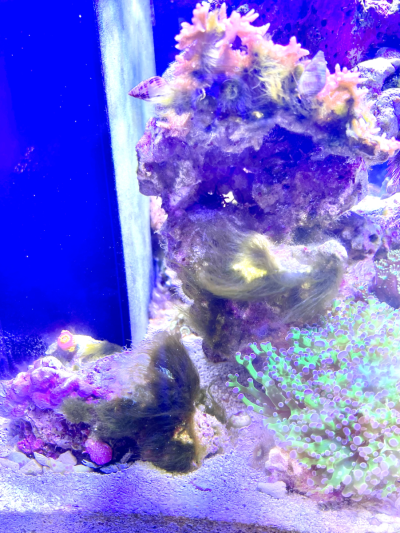I have had a nagging hair algae infestation that has taken hold of certain regions of the tank - mostly in lower light areas - and a few spots of bryopsis.
I have been treating for 3 weeks with a combination of Fluconazole (Flux RX) and Algaefix. I had heard mix messages on Fluconazole ability to treat hair algae so I doubled up to try to make sure I nail the algae. I still do my weekly water changes but, re-dose immediately after to match the expected concentration.
The bryopsis is essentially gone, but the hair algae, while reduced, is still hanging on. I think mechanical removal has been more effective than anything.
I've attached a picture here for ID as I assume there may be multiple species called "hair algae". The algae is very soft and wispy but very difficult to pull cleanly off the rock. Scrubbing with a tooth brush yields ok results where there is space to access but I can't quite get everywhere. The colors are a little off in the photo as i've optimized the color for viewing the algae.
Phosphate ranges from 0-0.02.
Any recommendations on additional treatments to try? None of my CUC will touch the stuff. My urchins will eat it if its between them and something they want to eat but I can't get them to eat it intentionally.
I know Hydrogen Peroxide is an option as well, but I've been avoiding because I've seen anecdotal reports of impact pod/microinvert populations. I also don't want to impact my coralline.

I have been treating for 3 weeks with a combination of Fluconazole (Flux RX) and Algaefix. I had heard mix messages on Fluconazole ability to treat hair algae so I doubled up to try to make sure I nail the algae. I still do my weekly water changes but, re-dose immediately after to match the expected concentration.
The bryopsis is essentially gone, but the hair algae, while reduced, is still hanging on. I think mechanical removal has been more effective than anything.
I've attached a picture here for ID as I assume there may be multiple species called "hair algae". The algae is very soft and wispy but very difficult to pull cleanly off the rock. Scrubbing with a tooth brush yields ok results where there is space to access but I can't quite get everywhere. The colors are a little off in the photo as i've optimized the color for viewing the algae.
Phosphate ranges from 0-0.02.
Any recommendations on additional treatments to try? None of my CUC will touch the stuff. My urchins will eat it if its between them and something they want to eat but I can't get them to eat it intentionally.
I know Hydrogen Peroxide is an option as well, but I've been avoiding because I've seen anecdotal reports of impact pod/microinvert populations. I also don't want to impact my coralline.





















